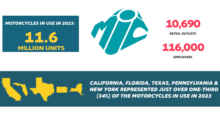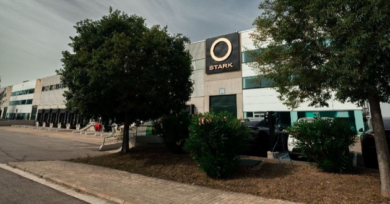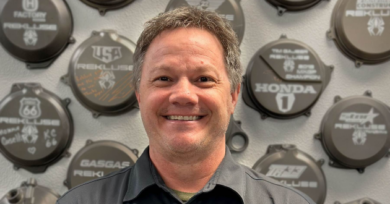Piecing together the Arctic Cat of tomorrow
 PLYMOUTH, Minn. — If you could pick the absolute worst-case date to start a new job in a new industry — let’s say, the powersports industry — then you would probably select some time in August of 2008. That’s right about the time the industry’s new unit sales volume began a staggering freefall, one that may not be repeated in terms of severity for decades to come.
PLYMOUTH, Minn. — If you could pick the absolute worst-case date to start a new job in a new industry — let’s say, the powersports industry — then you would probably select some time in August of 2008. That’s right about the time the industry’s new unit sales volume began a staggering freefall, one that may not be repeated in terms of severity for decades to come.
But that’s exactly when Claude Jordan began his career at Arctic Cat and why the former GE and Home Depot executive will take over the reins of the Minnesota manufacturer in the days to come rather than some time ago.
 “It’s an awfully challenging way to learn the business,” outgoing CEO Chris Twomey says of Jordan’s trial-by-fire.
“It’s an awfully challenging way to learn the business,” outgoing CEO Chris Twomey says of Jordan’s trial-by-fire.
But the experience and how Arctic Cat has emerged from it may reshape the company, beyond the previously announced change at the top. The manufacturer’s top two executives, outgoing CEO Twomey and incoming CEO Jordan, spoke to Powersports Business about the company’s succession plan and its interest in possibly expanding its product portfolio through acquisition.
Jordan has extensive experience in the merger and acquisition field, having concentrated on that for both GE and an Australian firm. Arctic Cat’s cash position, $80 million strong at the end of its most recent quarter, is more than six times higher than it was a year ago. Could those two pieces suggest the Jordan-led Arctic Cat — he takes over as CEO Jan. 1 — will look different than the one Twomey grew from a $7.5 million enterprise to one that finished its past fiscal year with $450 million in sales?
Certainly, there will be some changes, and in fact perhaps one of the most notable ones already has been set in motion. Arctic Cat is ending a decades-long engine partnership with Suzuki, although the end of that agreement is still a few model years away.
What about the company’s product portfolio? Jordan and Twomey both note Arctic Cat’s product development focus is evident in its 2011 lineup. “We’ve almost reinvented ourselves,” Jordan said. “If you go back over the past three years, 75 percent of our product line is new. We’re going to continue that same focus going forward.”
But will the Jordan-led Arctic Cat echo the Twomey-led era, a time when the company made a decisive decision to enter a new market (ATVs)? Could something of similar significance happen in the Jordan-led company?
“We’re not jumping into anything,” Jordan said. “We’re not doing an acquisition for the sake of doing an acquisition. If there is something that fits our image, that fits our brand, that fits our product portfolio, we’ll definitely go ahead and take a look at it.”
In fact, the company did just that in 2010, Jordan said, noting “we’ve taken a run at a couple of things earlier this year and they weren’t successful.
“You might look at 100 opportunities. You might get in serious discussions with 5-10 and you might end up buying one or two of them. It takes a long time to fill that pipeline and it takes a long time to find that something that fits from the product side and the culture side.”
Jordan compares an acquisition search to building a stable stool. The Arctic Cat “stool” currently has three legs, with its snowmobile, UTV and ATV sectors. Is there a fourth leg, a separate product line, that could be added to that stool?
“That’s something I work with Chris on and certainly talk about with the board,” Jordan said. “There’s no doubt that we would like to go ahead if there was something out there, to see if we can add that fourth leg.”
Could that leg be another product line within the industry, or something outside of powersports? “I don’t see us getting us into chainsaws,” Jordan quips, reaching back to his background at Home Depot. “I don’t seeing us going that far.
“Whatever direction we go, it will be somewhat related to powersports. I don’t see us going too far from where we’re strongest and where our brand is most recognized.”
Succession plan
Jordan joined Arctic Cat in the summer of 2008 as the general manager of the company’s ATV division. The hiring was part of a multi-step succession plan that the company crafted in 2006 as a way to eventually replace Twomey. The plan not only included a change at the top, but also moving the company’s leadership from northern Minnesota to the Twin Cities. The latter part of the plan was completed in 2008.
“The only part of the plan that got derailed was when the economy hit us as hard as it did,” Twomey said.
So instead of adding to the management team in the past two years, the company delayed the succession plan and was forced to make several difficult workforce reduction decisions.
“It just didn’t make sense for us to add additional layers of management given what was going on in the industry,” Twomey said.
Once hired, Jordan led an effort to significantly reduce inventory, both at the dealer and factory levels. Plus, and perhaps more importantly, the company’s ATV division began a new process where ordering decisions by dealers were made not once a year, but several times per year.
“We finished 2008 fiscal year with $127 million in inventory, most of it being ATV that had been built to plan rather than built to order,” Twomey said.
The inventory reduction at the dealer level amounted to a 25 percent decline last year and another 25 percent decrease this year. In-house levels also have been reduced, by 28 percent this year alone. Twomey calls this effort “probably the key that took us to profitability last year.” Arctic Cat finished its 2009 fiscal year with a net loss of more than $9 million. But with inventory in much better shape, the company concluded its most recent fiscal year with net earnings of nearly $2 million.
Engine building
In some ways, history will be repeating itself for Arctic Cat. In 2001, the company made a bold decision to eventually stop relying on Suzuki for the manufacturing of its ATV engines.
“They saw the ATV market vastly different than we saw the ATV market,” Twomey said of Suzuki. “We felt a strong need to give our customers the engines we thought they wanted, and Suzuki was not anywhere near as interested in developing those engines.”
So Arctic Cat went outside of its walls to find experienced engine builders. That part of the scenario — the hiring of external help — won’t necessarily be repeated as the model year 2015 approaches, the first year when Arctic Cat snowmobiles will not have Suzuki-built power plants.
Although Twomey notes snowmobile engines will be more challenging to build than ATVs because of their higher horsepower, “we come with a lot better experience, a lot more experience than we had on the ATV side” in engine development.
The decision to stop relying on Suzuki engines for its sleds will not only give the company more flexibility in product development, but also figures to be make an economic difference as well. Twomey admits after the ATV engine transition, the company struggled for a few years to match the cost of the Suzuki-built engines through its internal build model. But not only has that balanced out in the following years, but Arctic Cat has benefited from not having to pay a much more challenging currency exchange rate.
Twomey expects similar financial gains with the eventual conversation on the sled side.
“It looks like the financial side of that is going to pay off as well because we share the yen expense with Suzuki on the snow (engines),” he said.
Looking ahead
Arctic Cat’s main two markets — snowmobiles and ATVs — have been in a state of decline, at least on an industry level, for a number of years. What, in the upcoming days of a Jordan-led company, will Arctic Cat rely on to produce sales growth?
Jordan notes the company has picked up market share in both ATV and snowmobiles and continues to build its product offering in the side-by-side market, a market that many in the industry expect to grow in the short term. He also sees continued organic growth options, noting the company still has holes to fill on its product line.
To get a better idea of what those holes are, the company has once again begun holding smaller dealer meetings, something Twomey and Jordan refer to as “dealer town halls.” The three-four hour discussions with 10-15 dealers of different-sized operations allows Arctic Cat’s executive group to get an idea “of what’s working and what’s not working.”
Arctic Cat also is anticipating further growth in its international markets, including in Latin America and in the Middle East for its four-wheel business.
Plus, there’s the possibility of acquisition and what that could bring to the company.
“There’s no doubt there were some challenges along the way,” Jordan said, looking back at his first two years with Arctic Cat. “But we’ve gotten through those and we feel very good about where the business is today and where the business is going.” PSB
Reflecting back on 20-plus years as the Cat CEO
PLYMOUTH, Minn. — To try to encapsulate the past 20-something years is far from easy.
So as longtime CEO Chris Twomey was preparing to leave his office for his retirement, Powersports Business asked him to look back at that time and at least try to capture some of the better and more challenging moments of his tenure there.
Twomey guided Arctic Cat from a company that once employed 99 people to a firm that now has more than 1,300 employees. The company’s revenue during that period expanded at a similar rate, growing from $7.5 million to more than $450 million.
Powersports Business:
In your 24 years as CEO, what was the best decision you ever made?
Twomey:
“I think the best decision would have to be the people that we’ve brought into the business. It’s just been a great group of talented people. People obviously make this business work. We’ve had great people that supported (the executives), at the director level, at the management level and the people who make our product.”
Twomey cited the company’s recent snowmobile production celebration — it reached 1 million snowmobiles built — as an example. At the ceremony was a photo showing the initial 99 employees of Arctic Cat. “Twenty nine of them are still there after 27 years,” Twomey said.
Powersports Business:
What was the toughest decision you ever made?
Twomey:
“Couple of them. Exiting the PWC business, because we are product people and because it was a good product and we had fun in that business. But we just looked at it and said, ‘There’s no way we’re going to make money in this business.’ The industry was shrinking dramatically and we didn’t see an opportunity to make money.
Twomey recalls the morning of the PWC announcement. It happened to coincide on the morning of a press shoot when the company was making a brochure for the next year’s product line. “They called and said, ‘Now what do we do?’ We said, “Back up and come home.’ It was a very tough decision, but a good decision.
“The other tough decision was when we had to make adjustments in our overall workforce. Two years ago we reduced the workforce by about 12 percent, and that’s a really rough decision. These people are our friends, our associates. Those decisions get difficult.”
Powersports Business:
What is the toughest decision you can foresee coming in the future, but that you, at least as a CEO for Arctic Cat, won’t be making?
Twomey:
“I’m just incredibly optimistic about the industry. We’ve talked about the ATV industry bottoming out, and I think it will start to climb. I think in the snowmobile industry we’re going to see a good year this year. I know what we have for product development on the ATV side and on the snowmobile side. These are product-driven markets so that’s exciting. Our dealer network is smaller, but it’s stronger today.
“All of those things make me very optimistic. So I can’t sit here and say there’s one thing that I think is going to be a real challenge. There’s a whole lot we don’t know that will come up and will be tough decisions, but I feel very comfortable that we have a great team to take it forward.” PSB








